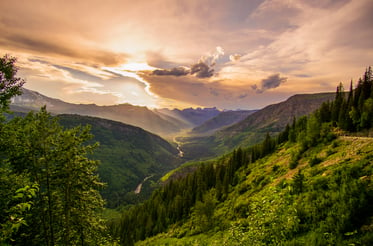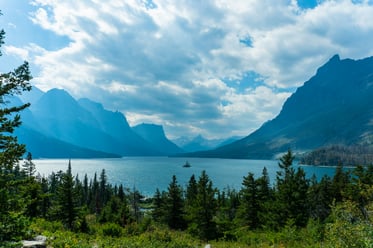Glacier National Park Destination Guide
Welcome to the Crown of the Continent! This essential guide will help you prepare for an unforgettable journey through Glacier National Park and Waterton Lakes.



Essential Travel Information
Everything you need to know before your Glacier National Park adventure
Border Crossing
- Passport Required: For crossing between the US and Canadian sides of the park.
- Border Hours: The Chief Mountain border crossing is only open seasonally (late May to late September).
- Global Entry/NEXUS: Can expedite border crossing if you have it.
- Children: May need additional documentation when traveling with only one parent.
Weather Considerations
- Summer: Daytime 70-80°F (21-27°C), nighttime 40-50°F (4-10°C).
- Shoulder Season: May/June and September/October can have snow at higher elevations.
- Winter: Most park facilities close. Temperatures often below freezing.
- Road Openings: Going-to-the-Sun Road typically fully opens mid/late June to mid-October.
Currency & Payments
- US Side: US Dollar (USD).
- Canadian Side: Canadian Dollar (CAD).
- Credit Cards: Widely accepted at park facilities, but not guaranteed at all locations.
- Cash: Recommended to carry some, especially for remote areas.
Mobile & Internet
- Cell Service: Very limited throughout the park, especially in backcountry areas.
- WiFi: Available at some visitor centers and lodges.
- Park App: Download NPS App before arriving for offline use.
- International Roaming: Consider a plan if crossing the border frequently.
Emergency Information
- US Emergency: 911
- Canada Emergency: 911
- Glacier National Park Emergency: 406-888-7800
- Waterton Lakes Emergency: 403-859-2636
Camping Experience for Glacier Park
Important information about our participatory camping adventure
This is a participatory camping trip, where all travelers will assist in setting up camp and cooking meals. Guides will teach you the best methods for quick set up and take down of tents and will lead the cooking, providing clear instructions and oversight. If you've never set up camp or cooked outdoors before, this is the perfect opportunity to learn under expert supervision!
We provide a diversity of foods containing the necessary nutrition for sustained energy output. Meals are made from staples that travel well - rice, pasta, lentils, beans, couscous, oatmeal, granola, etc. Meals are also supplemented with trail foods such as crackers, cheese, granola, energy bars, fresh and/or dried fruit, and energy drink mixes.
We regularly accommodate vegetarian diets and will make adjustments for food allergies. If you have any allergies or food intolerances please indicate them clearly on your traveler form.
Important note: It's critical that you include your dietary needs in your traveler form - it's too late once you've arrived!
- Tents: 3-person camping tents (7x7), double occupancy with camping pads.
- Gear Provided: All camping gear except for sleeping bags and pillows.
- Storage: Locked storage trailer behind the van for larger bags. Take day packs with you during activities.
- Charging: Limited outlets available near shower facilities. Power banks are recommended.
- Showers: Not all campsites have shower facilities. Your guide will arrange showers when needed (may require tokens, so keep cash/change on hand).
- Water: Clean drinking water provided at campgrounds in the mornings and throughout the day. Bring a bottle that can carry 2-4 liters.
- Waste Disposal: Front country campgrounds have trash receptacles. Bathrooms accessible at campgrounds and during the day.
Your tour will be led by a trained, experienced professional with a solid guiding background, years of personal wilderness and hiking experience, medical certifications, and a passion for leading people into breathtaking landscapes.
Important note: Guides are required to take 8 hours of each 24-hour period to sleep, recuperate, take personal/downtime, etc. In addition, as part of the 8 hours off they must sleep/rest or be in their tents uninterrupted for a minimum of 5 hours each night. We ask guests to respect these requirements and not interrupt Guides' time off and sleep time unless there is a true (life-threatening) emergency.
Packing Advice
As we will be using shared transfers and spaces throughout our tour we recommend all travelers pack as lightly as possible. Please review our luggage restrictions in the packing section.
Mosquito Protection: Tight-weave cotton shirts and pants work better than more porous synthetics. Wear khaki or other neutral colors. Mosquitoes are attracted to dark colors, especially blue. Stay away from scented soaps, lotions and shampoos.
Packing Checklist for Glacier Park
Use this checklist to ensure you pack everything you need for your Glacier National Park adventure
Travel Documents & Essentials
- Passport (for crossing US/Canada border)
- Driver's license or photo ID
- Park passes and reservations (print copies)
- Travel insurance details
- Credit/debit cards
- Cash (both USD and CAD)
- Car insurance & registration (if driving)
- Travel wallet or money belt
- Copies of important documents (separate from originals)
- Emergency contact information
Clothing & Footwear
- Moisture-wicking base layers
- Insulating mid layers (fleece/wool)
- Waterproof/windproof outer shell
- Hiking pants (convertible pants are versatile)
- Hiking boots (broken in)
- Hiking socks (several pairs)
- Hat with brim for sun protection
- Warm beanie (even in summer for high elevations)
- Gloves or mittens
- Casual clothes for evenings
Hiking & Outdoor Gear
- Daypack (20-30L with rain cover)
- Trekking poles
- Headlamp or flashlight with extra batteries
- Water bottles or hydration reservoir (2-3L capacity)
- Water filter/purification method
- Binoculars for wildlife viewing
- Navigation tools (map, compass, GPS device)
- Multi-tool or pocket knife
- Waterproof stuff sacks for electronics/valuables
Health & Safety
- Prescription medications (in original containers)
- First-aid kit with blister treatment
- Insect repellent
- Sunscreen (SPF 30+ and environmentally friendly)
- Lip balm with SPF
- Hand sanitizer
- Pain relievers
- Allergy medication
- Moleskin or blister bandages
- Personal toiletries
Packing Tips
- Layer Up: Mountain weather can change rapidly. Pack clothing that can be easily layered.
- Stay Hydrated: Bring more water than you think you'll need, especially during summer hikes.
- Leave No Trace: Pack a small trash bag to carry out all your waste.
Local Food & Dining Experiences
The Glacier region offers a variety of dining experiences from rustic lodge restaurants to small-town cafés. Here are some foods and dishes to try:
Huckleberry Everything
Try this wild local berry in pies, ice cream, jam, or even beer.
Bison Burgers
A leaner alternative to beef with rich flavor and local heritage.
Montana Trout
Freshly caught and simply prepared for a true taste of the region.
Flapjacks
Start your day with hearty mountain-sized pancake breakfasts.
Craft Beer
Montana and Alberta boast excellent microbreweries worth sampling.
Saskatoon Berry Pie
A Canadian prairie specialty similar to blueberry but uniquely flavorful.
Bear Safety Information
Important guidelines for staying safe in bear country
Seeing a bear in the wild is a special treat for any visitor. While it is an exciting moment, it is important to remember that bears in national parks are wild and can be dangerous. Their behavior is sometimes unpredictable. Although rare, attacks on humans have occurred, inflicting serious injuries and death. Each bear and each experience is unique; there is no single strategy that will work in all situations and that guarantees safety. Most bear encounters end without injury.
Precautions Taken By Your Guide
- Food will be stored in containers and put in the locked storage when not in use.
- Guides will carry bear spray and "bear poppers" or noise-making devices.
- Trash and food waste will be properly disposed of in bear-proof trashcans or safely stored until the next safe disposal location.
- Your Guide will have bear spray and noise deterrents on them to use if necessary.
We do not recommend traveling or bringing your own bear spray. Instead, you can protect yourself and lessen the threat of danger by following some basic guidelines.
If You Encounter a Bear
- Keep Your Distance: Never approach a bear. Always remain at least 100 yards (300 feet) away.
- Identify Yourself: Remain calm and talk calmly so the bear knows you are a human and not a prey animal.
- Stand Your Ground: Remain still but slowly wave your arms to help the bear recognize you as a human.
- Stay Calm: A scream or sudden movement may trigger an attack. Never imitate bear sounds or make high-pitched squeals.
- Travel in Groups: Groups are noisier and more intimidating to bears.
- Look Larger: Move to higher ground to make yourself look as large as possible.
- Protect Your Food: Do NOT allow the bear access to your food.
If a Bear Notices You
- Move Away Slowly: If the bear is stationary, move away slowly and sideways while keeping an eye on the bear.
- Do NOT Run: Bears can run as fast as a racehorse both uphill and down. Like dogs, they will chase fleeing animals.
- Change Your Route: Leave the area or take a detour. If impossible, wait until the bear moves away.
- Avoid Cubs: Be especially cautious around a female with cubs; never place yourself between a mother and her cub.
Your Guides will provide instructions on how to act during bear encounters. For a comprehensive list of tips, you can visit the U.S. National Parks Service or Parks Canada's website.
Park Etiquette & Responsible Travel
Tips for enjoying Glacier National Park responsibly while preserving it for future generations
Wildlife Safety
- Bear Awareness: Always carry bear spray, make noise while hiking, and properly store food/scented items.
- Safe Distances: Stay at least 100 yards (91 m) from bears and wolves, 25 yards (23 m) from all other wildlife.
- Never Feed Wildlife: Human food damages wildlife health and creates dangerous situations.
- Dawn/Dusk Caution: Be extra alert during these prime wildlife activity times.
- Roadside Wildlife: Pull completely off the road and keep a safe distance if viewing animals.
Leave No Trace
- Pack It In, Pack It Out: Carry all trash back with you, including food scraps.
- Stay on Trails: Protect fragile alpine vegetation by not taking shortcuts or creating new paths.
- Respect Closures: Trail and area closures protect both wildlife and visitors.
- Proper Waste Disposal: Use restroom facilities when available or bury human waste 6-8 inches deep, 200 feet from water sources.
- Leave What You Find: Do not collect plants, rocks, antlers, or artifacts.
⚠️ Important Safety Note
Weather in the mountains can change rapidly. Always check the forecast before heading out, be prepared for sudden changes, and know when to turn back. Hypothermia can occur even in summer when wet and exposed to wind at high elevations.
Additional Travel Tips
- Early Starts: Beat crowds by arriving at trailheads before 8am.
- Shuttle Service: Use the free park shuttle on Going-to-the-Sun Road during peak season.
- Need help searching for a flight? We recommend Skyscanner.com to compare different routes and rates. Click here to search!
- Pack Layers: Mountain weather changes rapidly throughout the day.
- Take Your Time: Don't try to see everything in one trip.
- Consider Shoulder Season: Late June and early September offer fewer crowds.
Tipping
Tipping Suggestions: Tips for guides, drivers and restaurants are not included. Tips provide supplemental income, and, while not mandatory, are greatly appreciated. If the local teams have added to the experience, please reward them.
Your Guide will also often be your driver throughout your trip. In this case we recommend tipping the combined amount ($20-30) per person/per day.
| Guides | USD $10-15 per person/per day | |
| Drivers | USD $10-15 per person/per day |
